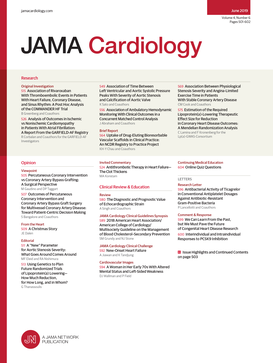Finerenone and Atrial Fibrillation in Heart Failure
IF 14.8
1区 医学
Q1 CARDIAC & CARDIOVASCULAR SYSTEMS
引用次数: 0
Abstract
ImportanceHeart failure (HF) with mildly reduced or preserved ejection fraction and atrial fibrillation (AF) are closely intertwined.ObjectiveTo examine the efficacy and safety of the nonsteroidal mineralocorticoid receptor antagonist finerenone in patients with HF with mildly reduced or preserved ejection fraction according to the absence or presence of AF and the type of AF (paroxysmal vs persistent or permanent).Design, Setting, and ParticipantsPrespecified analyses were conducted in the Finerenone Trial to Investigate Efficacy and Safety Superior to Placebo in Patients With Heart Failure (FINEARTS-HF) randomized clinical trial. The trial was conducted across 653 sites in 37 countries. Participants were adults aged 40 years and older with symptomatic HF and left ventricular ejection fraction of 40% or greater, randomized between September 2020 and January 2023. Data analysis was conducted from September 1 to October 1, 2024.InterventionFinerenone (titrated to 20 mg or 40 mg) or placebo.Main Outcomes and MeasuresThe primary outcome was the composite of total HF events and cardiovascular death. New-onset AF or atrial flutter (AFL) was a prespecified exploratory outcome.ResultsAmong 5984 patients (mean [SD] age, 72.0 [9.6] years; 2724 [45.5%] female) with known AF status at baseline, 1384 (23.1%) had paroxysmal AF and 1886 (31.5%) had persistent or permanent AF. Patients with both types of AF were older and had worse HF status compared with those without AF (2714 patients [45.4%]). Both types of AF were associated with a higher unadjusted risk of the primary outcome compared with no AF (event rate per 100 person-years of follow-up, 20.3 [95% CI, 17.9-23.1] with paroxysmal AF, 19.8 [95% CI, 17.8-22.0] with persistent or permanent AF, and 11.9 [95% CI, 10.7-13.3] with no AF; rate ratio [RR], 1.62 [95% CI, 1.37-1.92] with paroxysmal AF and 1.66 [95% CI, 1.43-1.93] with persistent or permanent AF vs no AF); however, the associations were attenuated after adjustment for known prognostic variables. The benefit of finerenone on the primary outcome (overall RR, 0.84 [95% CI, 0.74-0.95]) was not modified by baseline AF status (RR, 0.80 [95% CI, 0.65-0.98] with no AF, 0.83 [95% CI, 0.65-1.06] with paroxysmal AF, and 0.85 [95% CI, 0.69-1.05] with persistent or permanent AF;求助全文
约1分钟内获得全文
求助全文
来源期刊

JAMA cardiology
Medicine-Cardiology and Cardiovascular Medicine
CiteScore
45.80
自引率
1.70%
发文量
264
期刊介绍:
JAMA Cardiology, an international peer-reviewed journal, serves as the premier publication for clinical investigators, clinicians, and trainees in cardiovascular medicine worldwide. As a member of the JAMA Network, it aligns with a consortium of peer-reviewed general medical and specialty publications.
Published online weekly, every Wednesday, and in 12 print/online issues annually, JAMA Cardiology attracts over 4.3 million annual article views and downloads. Research articles become freely accessible online 12 months post-publication without any author fees. Moreover, the online version is readily accessible to institutions in developing countries through the World Health Organization's HINARI program.
Positioned at the intersection of clinical investigation, actionable clinical science, and clinical practice, JAMA Cardiology prioritizes traditional and evolving cardiovascular medicine, alongside evidence-based health policy. It places particular emphasis on health equity, especially when grounded in original science, as a top editorial priority.
 求助内容:
求助内容: 应助结果提醒方式:
应助结果提醒方式:


